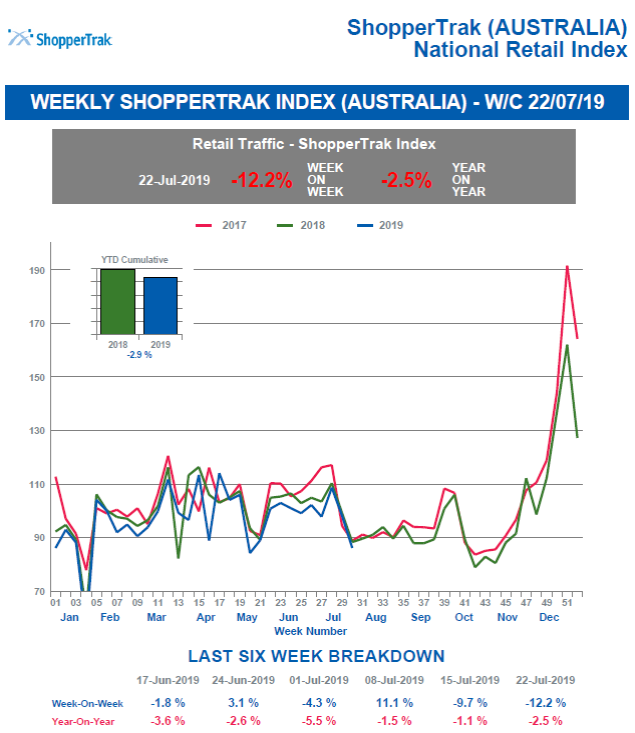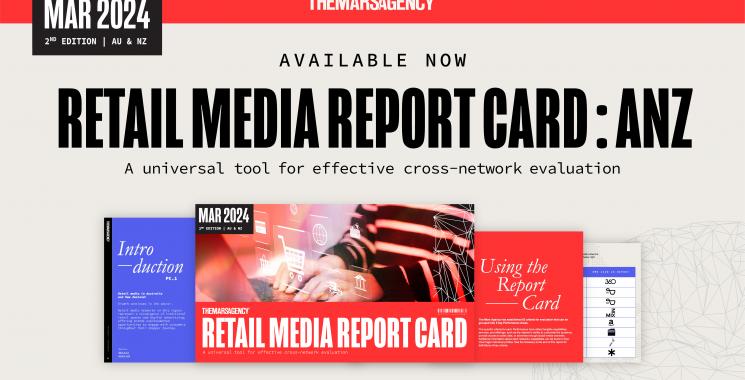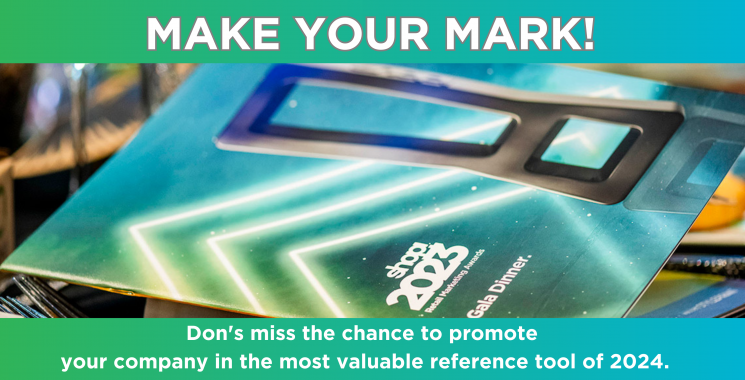ShopperTrak Trends & Targeting Gen Z Jul-Aug 2019
 July 2019 Wrap-up
July 2019 Wrap-up
In the last week of July, the National Index was down -12.2% from the week before and down -2.5% compared to this time last year.
Earlier in July, the National Retail Index was down 4.3% from the week before and down -5.5% compared to this time last year.
Retail traffic historically encounters a slump in the months post EOFY, during these times it’s imperative to maximize customers in store.
According a sample of conversion rates we are seeing that ‘shoppers’ during these times are actually more engaged – meaning more sales opportunity.
Six trends that retailers can use to capitalise on Gen Z’s use of stores
Third Party content from FashionUnited and ShopperTrak, Europe

Fashion retail is famously fast-paced and inventive, but the bar has been raised even higher in 2019 as a major global generational shift takes place, with predictions showing that Gen Z will outnumber Millennials as the most populous generation - FashionUnited spoke to global retail intelligence experts, ShopperTrak, to find out why retailers should be conscious of how younger shoppers use stores.
1. Self-service payments for an easy life
It’s not just the grocery sector that has embraced self-service technology, recent store openings by Nike and Zara owner Inditex have included self-service facilities, enabling their core demographic to choose items and leave without passing through a traditional till-point. Self-service payment terminals and phone apps are already proving a hit with the youngest shoppers, who have been born into a world of automation and who expect immediate gratification and convenience.
Self-checkout machines free up time for staff, allowing them to balance other responsibilities much more efficiently, while traffic data can be used to optimise labour scheduling and improve store performance by adjusting the number of store associates in relation to the volume of shoppers, as well as helping improve employee engagement.
2. AR and VR enhances the physical retail experience
Digital signage, VR, AR and location-based marketing, which connects the digital world with the physical world, is a big opportunity in apparel retailing and ShopperTrak is advising retailers to invest in unique in-store experiences to drive traffic.
Early trials by Zara, Burberry and Gucci have allowed customers to interact with new ranges via smartphone apps that bring displays and images to life and connect to the buy button. The challenge will be managing costs while at the same driving higher rates of conversion. Traffic data analytics can help in understanding the shopper journey and behaviour patterns that come from such new in-store features, enabling retailers to introduce news way of connecting with customers, with certainty that they will deliver value.
3. Embrace gender-neutral fashion ranges
Diversity and inclusion continue to big news and there is a strong affinity amongst Gen Z shoppers for freedom of expression and the right of an individual to celebrate their life choices, and gender fluidity is a major part of this. Research shows that 56 percent of Gen Z already shop outside of their specific gender, according to a 2016 study presented by global advertising agency JWT.
H&M spotted this trend last year and launched a unisex collection with cult footwear brand Eytys to offer a selection of genderless sneakers, shoes and boots, alongside jackets, tops, trousers and jeans in a bid to offer customers styles that span genders.
4. Targeting Gen Z with ShopperTrak retail insights
Gender neutral ranges will be new territory for apparel and footwear retailers who need to analyse their store traffic and customer behaviour data to hone their offer, explains ShopperTrak, and their traffic data will be able to reveal whether or not shoppers would like assistance, where in the store is best to locate the ranges, whether dedicated fitting rooms are needed, as well as what conversion rates are possible.
5. Pop-ups and ‘Instagrammable’ spaces
Pop-up stores are a hit with the Gen Z, because, as the name suggests they are temporary and therefore create a ‘fear of missing out’. In the age of social sharing, pop-up stores should therefore be designed and laid out with Instagrammable spaces that offer “unique, memorable and sharable experiences” for visitors.
Pop-ups also allow apparel brands to extend their reach into the community, and showcase their wider brand values, for instance fitness and lifestyle brand New Balance launched a pop up destination combining a pub, a gym studio and running clubs, as part of its promotion of the brand’s London Marathon sponsorship.
“Being much more flexible and getting physically close to the customers is what really matters. Online is only a click away and physical stores should only be steps away to be successful – this can be done with Pop-ups or similar formats. And it is not about the price, Gen Z is willing to pay a premium for the right service and experience,” added Hillebrand.
6. Conscientious consumerism comes alive in stores
Gen Z-ers and Millennials are looking to ascribe to companies that focus on sustainability and have a socially beneficial purpose and stores can help retailers put socially conscientious policies into visible action.
With the emergence of companies like Rent the Runway, Le Tote and Poshmark offering the concept of renting clothes, and buying less, high street brands such as H&M have well-publicised apparel recycling points in stores, and department store John Lewis has trialled buying back customers’ unwanted garments to reduce landfill.
ShopperTrak advises retailers to look at their traffic data to build an understanding of how stores could be used for new recycling efforts, with the data explaining how many visitors take part, as well as which store locations are best suited to offering clothing drop off points.
Third Party content, Targeting Gen Z with ShopperTrak retail insights by FashionUnited and ShopperTrak, Europe












